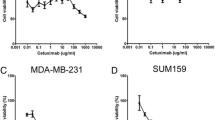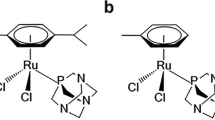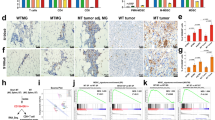Abstract
Breast cancer stem cells (BrCSC) are resistant to common therapeutic modalities including chemotherapy, radiation, and hormonal agents. They are thought to contribute to treatment resistance, relapse, and metastases. This study examines the effect of a monoclonal anti-DR5 antibody (TRA-8) and chemotherapy (adriamycin, taxol) on BrCSC populations from basal-like breast cancer cell lines. Doubly enriched BrCSC (CD44+, CD24−, ALDH+) cells were exposed to TRA-8 and control reagents and examined for cytotoxicity, caspase activation, tumorsphere formation and tumorigenicity. Doubly enriched BrCSC populations expressed cell surface DR5 and were sensitive to TRA-8 mediated cytotoxicity with induction of caspase 8 and 3 activation. TRA-8 at sub-nanomolar concentrations inhibited 2LMP and SUM159 BrCSC tumorsphere formation and was more than 50-fold more inhibitory than TRAIL or anti-DR4 at equimolar concentrations. Chemotherapy treatment of 2LMP and SUM159 cell lines resulted in a relative increase of BrCSC, whereas TRA-8 produced a decrease in the percentage of BrCSC. TRA-8 exposure to 2LMP and SUM159 BrCSC preparations produced significant inhibition of tumorigenicity. DR5 maybe a therapeutic target on the surface of basal-like BrCSC which is amenable to agonistic monoclonal anti-DR5 therapy.





Similar content being viewed by others
References
Liedtke C, Gonzalez-Angulo A-M, Pusztai L (2010) Definition of triple-negative breast cancer and relationship to basal-like molecular subtype. PPO Updat Prin Prac Oncol 24:1–6
Nielsen TO, Hsu FD, Jensen K, Cheang M, Karaca G, Hu Z, Hernandez-Boussard T, Livasy C, Cowan D, Dressler L, Akslen LA, Ragaz J, Gown AM, Gilks CB, van de Rijn M, Perou CM (2004) Immunohistochemical and clinical characterization of the basal-like subtype of invasive breast carcinoma. Clin Cancer Res 10(16):5367–5374. doi:10.1158/1078-0432.CCR-04-0220
Lakhani SR, Reis-Filho JS, Fulford L, Penault-Llorca F, van der Vijver M, Parry S, Bishop T, Benitez J, Rivas C, Bignon YJ, Chang-Claude J, Hamann U, Cornelisse CJ, Devilee P, Beckmann MW, Nestle-Kramling C, Daly PA, Haites N, Varley J, Lalloo F, Evans G, Maugard C, Meijers-Heijboer H, Klijn JG, Olah E, Gusterson BA, Pilotti S, Radice P, Scherneck S, Sobol H, Jacquemier J, Wagner T, Peto J, Stratton MR, McGuffog L, Easton DF (2005) Prediction of BRCA1 status in patients with breast cancer using estrogen receptor and basal phenotype. Clin Cancer Res 11(14):5175–5180. doi:10.1158/1078-0432.CCR-04-2424
Honeth G, Bendahl PO, Ringner M, Saal LH, Gruvberger-Saal SK, Lovgren K, Grabau D, Ferno M, Borg A, Hegardt C (2008) The CD44+/CD24− phenotype is enriched in basal-like breast tumors. Breast Cancer Res 10(3):R53. doi:10.1186/bcr2108
Charafe-Jauffret E, Ginestier C, Iovino F, Wicinski J, Cervera N, Finetti P, Hur MH, Diebel ME, Monville F, Dutcher J, Brown M, Viens P, Xerri L, Bertucci F, Stassi G, Dontu G, Birnbaum D, Wicha MS (2009) Breast cancer cell lines contain functional cancer stem cells with metastatic capacity and a distinct molecular signature. Cancer Res 69(4):1302–1313. doi:10.1158/0008-5472.CAN-08-2741
Giatromanolaki A, Sivridis E, Fiska A, Koukourakis MI (2010) The CD44+/CD24− phenotype relates to ‘triple-negative’ state and unfavorable prognosis in breast cancer patients. Med Oncol. doi:10.1007/s12032-010-9530-3
Dontu G (2008) Breast cancer stem cell markers—the rocky road to clinical applications. Breast Cancer Res 10(5):110. doi:10.1186/bcr2130
Bonnet D, Dick JE (1997) Human acute myeloid leukemia is organized as a hierarchy that originates from a primitive hematopoietic cell. Nat Med 3(7):730–737
Ailles LE, Weissman IL (2007) Cancer stem cells in solid tumors. Curr Opin Biotechnol 18(5):460–466. doi:10.1016/j.copbio.2007.10.007
Al-Hajj M, Wicha MS, Benito-Hernandez A, Morrison SJ, Clarke MF (2003) Prospective identification of tumorigenic breast cancer cells. Proc Natl Acad Sci USA 100(7):3983–3988. doi:10.1073/pnas.0530291100
Ginestier C, Hur MH, Charafe-Jauffret E, Monville F, Dutcher J, Brown M, Jacquemier J, Viens P, Kleer CG, Liu S, Schott A, Hayes D, Birnbaum D, Wicha MS, Dontu G (2007) ALDH1 is a marker of normal and malignant human mammary stem cells and a predictor of poor clinical outcome. Cell Stem Cell 1(5):555–567. doi:10.1016/j.stem.2007.08.014
Donnenberg VS, Donnenberg AD, Zimmerlin L, Landreneau RJ, Bhargava R, Wetzel RA, Basse P, Brufsky AM (2010) Localization of CD44 and CD90 positive cells to the invasive front of breast tumors. Cytom B Clin Cytom 78(5):287–301. doi:10.1002/cyto.b.20530
Meyer MJ, Fleming JM, Lin AF, Hussnain SA, Ginsburg E, Vonderhaar BK (2010) CD44posCD49fhiCD133/2hi defines xenograft-initiating cells in estrogen receptor-negative breast cancer. Cancer Res 70(11):4624–4633. doi:10.1158/0008-5472.CAN-09-3619
Pece S, Tosoni D, Confalonieri S, Mazzarol G, Vecchi M, Ronzoni S, Bernard L, Viale G, Pelicci PG, Di Fiore PP (2010) Biological and molecular heterogeneity of breast cancers correlates with their cancer stem cell content. Cell 140(1):62–73. doi:10.1016/j.cell.2009.12.007
Fillmore CM, Kuperwasser C (2008) Human breast cancer cell lines contain stem-like cells that self-renew, give rise to phenotypically diverse progeny and survive chemotherapy. Breast Cancer Res 10(2):R25. doi:10.1186/bcr1982
Croker AK, Goodale D, Chu J, Postenka C, Hedley BD, Hess DA, Allan AL (2009) High aldehyde dehydrogenase and expression of cancer stem cell markers selects for breast cancer cells with enhanced malignant and metastatic ability. J Cell Mol Med 13(8B):2236–2252. doi:10.1111/j.1582-4934.2008.00455.x
Debeb BG, Xu W, Woodward WA (2009) Radiation resistance of breast cancer stem cells: Understanding the clinical framework. J Mammary Gland Biol Neoplasia 14(1):11–17. doi:10.1007/s10911-009-9114-z
Ricardo S, Vieira AF, Gerhard R, Leitao D, Pinto R, Cameselle-Teijeiro JF, Milanezi F, Schmitt F, Paredes J (2011) Breast cancer stem cell markers CD44, CD24 and ALDH1: expression distribution within intrinsic molecular subtype. J Clin Pathol. doi:10.1136/jcp.2011.090456
Kakarala M, Wicha MS (2008) Implications of the cancer stem-cell hypothesis for breast cancer prevention and therapy. J Clin Oncol 26(17):2813–2820. doi:10.1200/JCO.2008.16.3931
DeRosier LC, Vickers SM, Zinn KR, Huang Z, Wang W, Grizzle WE, Sellers JC, Stockard CR Jr, Zhou T, Oliver PG, Arnoletti JP, LoBuglio AF, Buchsbaum DJ (2007) TRA-8 anti-DR5 monoclonal antibody and gemcitabine induce apoptosis and inhibit radiologically validated orthotopic pancreatic tumor growth. Mol Cancer Ther 6:3198–3207. doi:10.1158/1535-7163.MCT-07-0299
Oliver PG, LoBuglio AF, Zinn KR, Kim H, Nan L, Zhou T, Wang W, Buchsbaum DJ (2008) Treatment of human colon cancer xenografts with TRA-8 anti-death receptor 5 antibody alone or in combination with CPT-11. Clin Cancer Res 14:2180–2189. doi:10.1158/1078-0432.CCR-07-1392
Amm HM, Zhou T, Steg AD, Kuo H, Li Y, Buchsbaum DJ (2011) Mechanisms of drug sensitization to TRA-8, an agonistic death receptor 5 antibody, involve modulation of the intrinsic apoptotic pathway in human breast cancer cells. Mol Cancer Res 9:403–417
Bevis KS, McNally LR, Sellers JC, Della Manna D, Londoño-Joshi A, Amm H, Straughn JJM, Buchsbaum DJ (2011) Anti-tumor activity of an anti-DR5 monoclonal antibody, TRA-8, in combination with taxane/platinum-based chemotherapy in an ovarian cancer model. Gynecol Oncol 121(1):193–199
Forero-Torres A, Oliver PG, Joshi AIL, Zhou T, LoBuglio AF, Buchsbaum DJ (2010) Death receptor 5, a therapeutic target for triple negative breast cancer. In: The Breast Cancer Symposium 2010, San Antonio, Texas, 8–12 December 2010
Ichikawa K, Liu W, Zhao L, Wang Z, Liu D, Ohtsuka T, Zhang H, Mountz JD, Koopman WJ, Kimberly RP, Zhou T (2001) Tumoricidal activity of a novel anti-human DR5 monoclonal antibody without hepatocyte cytotoxicity. Nat Med 7:954–960. doi:10.1038/91000
Buchsbaum DJ, Zhou T, Grizzle WE, Oliver PG, Hammond CJ, Zhang S, Carpenter M, LoBuglio AF (2003) Antitumor efficacy of TRA-8 anti-DR5 monoclonal antibody alone or in combination with chemotherapy and/or radiation therapy in a human breast cancer model. Clin Cancer Res 9:3731–3741
Hill AV (1910) The possible effects of the aggregation of the molecules of haemoglobin on its dissociation curves. J Physiol 40:4–7
Gibbons JD (1971) Nonparametric statistical inference. McGraw-Hill, New York
Grimshaw MJ, Cooper L, Papazisis K, Coleman JA, Bohnenkamp HR, Chiapero-Stanke L, Taylor-Papadimitriou J, Burchell JM (2008) Mammosphere culture of metastatic breast cancer cells enriches for tumorigenic breast cancer cells. Breast Cancer Res 10(3):R52. doi:10.1186/bcr2106
Rahman M, Davis SR, Pumphrey JG, Bao J, Nau MM, Meltzer PS, Lipkowitz S (2009) TRAIL induces apoptosis in triple-negative breast cancer cells with a mesenchymal phenotype. Breast Cancer Res Treat 113:217–230. doi:10.1007/s10549-008-9924-5
Rajeshkumar NV, Rasheed ZA, Garcia-Garcia E, Lopez-Rios F, Fujiwara K, Matsui WH, Hidalgo M (2010) A combination of DR5 agonistic monoclonal antibody with gemcitabine targets pancreatic cancer stem cells and results in long-term disease control in human pancreatic cancer model. Mol Cancer Ther 9(9):2582–2592. doi:10.1158/1535-7163.MCT-10-0370
Sussman RT, Ricci MS, Hart LS, Sun SY, El-Deiry WS (2007) Chemotherapy-resistant side-population of colon cancer cells has a higher sensitivity to TRAIL than the non-SP, a higher expression of c-Myc and TRAIL-receptor DR4. Cancer Biol Ther 6(9):1490–1495
Capper D, Gaiser T, Hartmann C, Habel A, Mueller W, Herold-Mende C, von Deimling A, Siegelin MD (2009) Stem-cell-like glioma cells are resistant to TRAIL/Apo2L and exhibit down-regulation of caspase-8 by promoter methylation. Acta Neuropathol 117(4):445–456. doi:10.1007/s00401-009-0494-3
Forero-Torres A, Shah J, Wood T, Posey J, Carlisle R, Copigneaux C, Luo FR, Wojtowicz-Praga S, Percent I, Saleh M (2010) Phase I trial of weekly tigatuzumab, an agonistic humanized monoclonal antibody targeting death receptor 5 (DR5). Cancer Biother Radiopharm 25:13–19. doi:10.1089/cbr.2009.0673
Acknowledgments
Supported in part by NIH SPORE in Breast Cancer 5P50 CA089019-08, Komen for the Cure Promise Grant KG090969, Breast Cancer Research Foundation of Alabama, and DOD Training grant W81XWH-11-1-0151. The authors thank Dr. William Grizzle for histologic analysis of tumor grafts. Technical support was provided by Andres Aristizabal and Enid Keyser. D. J. Buchsbaum and Albert F. LoBuglio: intellectual property interest in TRA-8, Daiichi Sankyo.
Author information
Authors and Affiliations
Corresponding authors
Rights and permissions
About this article
Cite this article
Londoño-Joshi, A.I., Oliver, P.G., Li, Y. et al. Basal-like breast cancer stem cells are sensitive to anti-DR5 mediated cytotoxicity. Breast Cancer Res Treat 133, 437–445 (2012). https://doi.org/10.1007/s10549-011-1763-0
Received:
Accepted:
Published:
Issue Date:
DOI: https://doi.org/10.1007/s10549-011-1763-0




